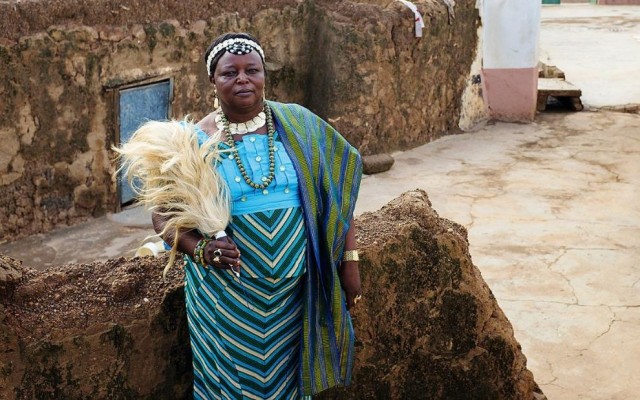Queens and Queen Mothers
African monarchies have always been dominated by men. Their authority over kingdoms is patterned on the role of male heads of households and families. However, royal women have held and still hold considerable power. A few have reigned as queens in their own right, but more often the power, influence, and responsibility of royal women lies in their relationship to kings, as mothers, sisters, or wives.
Only a few cases of ruling queens are known. The Lovedu kingdom of SOUTH AFRICA switched from a king to a queen in about 1800, and all Lovedu rulers since that time have been female. Known as Rain-Queens, they have little political authority but are believed to have mystical power over rain. The Rain-Queen is symbolically both male and female. She has no husband and is not supposed to bear children. In return for rain, chiefs and nobles present her with “wives,” and she in turn gives these wives to other nobles. The children of these unions regard the Rain-Queen as their father.

In the 1800s women took over the monarchies of the Merina and Sakalava peoples of MADAGASCAR. Europeans were gaining influence in the area, and the people of these kingdoms may have put queens rather than kings on the throne in an attempt to avoid conflict with Europeans. Among both groups, queens are referred to in language that conceals the fact that they are women. The Merina queen is called “the person who rules,” while the Sakalava queen is addressed as a male. Although reigning queens are rare, in most African kingdoms certain female relatives of the king have important roles. They may act as regents for kings who are too young to rule, or they may maintain courts of their own and exercise powers similar to those of senior chiefs. These women are generally the sisters or mothers of kings. Most African kings have many wives, and although the wives play significant roles, they seldom have influence over the entire kingdom. Instead, they serve as representatives at court for their various clans.
A king's sister, on the other hand, may be regarded as a partner in rule. The Lozi people of ZAMBIA divide their kingdom into northern and southern parts, with identical capitals 25 miles apart. The southern one is ruled by a sister of the king, who has her own chiefs, advisers, and army. Her realm serves as a refuge from the king's anger.
The queen mother, who may be the king's mother or another female relative, can have similar powers. Among the Shi people of eastern CONGO (KINSHASA), the queen mother controls about half the land in the kingdom and rules until her son is old enough to take power. Among the ASANTE and other matrilineal peoples of GHANA, queen mothers do not rule the kingdom, but they have the authority of royal men to judge issues. They are not just female chiefs—in fact, they have the same royal status as a man does, and they even dress as men and have more freedom in marriage than other women.
The Ganda kingdom of UGANDA illustrates how complex the roles of royal African women can be. Kingship is divided between the living king and the most recently deceased king. Both are addressed by the title kabaka, and so are the mother of the living king, his oldest sister or half sister, known as the queen sister, and his chief wife. Together, these individuals form a total kingship. (See also Cleopatra; Gender Roles and Sexuality; Kings and Kingship; Kinship; Marriage Systems; Ranavalona, Mada; Women in Africa.)